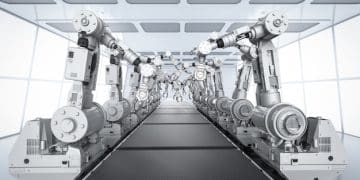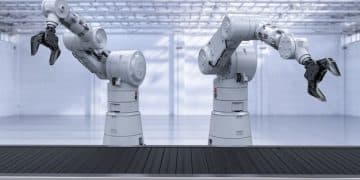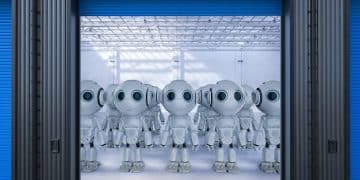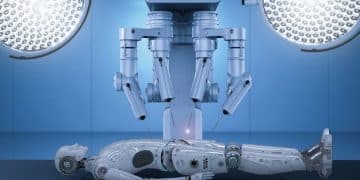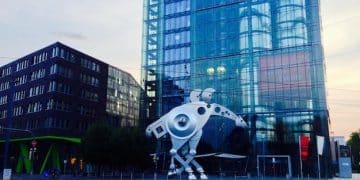US Robotics Industry Poised for 12% Growth in 2025: Key Drivers Revealed

Projections indicate the US robotics industry growth: projections show a 12% increase in 2025 – what’s driving it? is set for a significant 12% expansion driven by advanced automation, AI integration, and evolving market demands across various sectors.
The landscape of modern manufacturing, healthcare, and logistics is rapidly being reshaped by technological advancements, with robotics at its core. As we look towards the next few years, the US robotics industry growth: projections show a 12% increase in 2025 – what’s driving it? stands out as a particular area of interest, promising transformative changes and substantial economic impact. Understanding the forces behind this anticipated surge is crucial for businesses, innovators, and policy-makers alike.
The evolving landscape of US robotics
The US robotics industry is not merely expanding; it is undergoing a profound evolution. From clunky industrial machines to sophisticated, AI-powered collaborators, robots are becoming integral to a diverse range of applications. This transformation is driven by a confluence of technological breakthroughs, shifting economic paradigms, and a growing recognition of automation’s multifaceted benefits.
Historically, industrial robots were confined to repetitive, heavy-duty tasks in manufacturing plants. While this sector remains a significant driver, the scope has broadened considerably. Today, we witness robots in surgical suites, warehouses, last-mile delivery, and even in our homes, performing tasks that require perception, dexterity, and adaptive intelligence.
Technological advancements fueling growth
A primary catalyst for this projected 12% growth is the relentless pace of innovation in robotics. Key technological advancements are making robots more accessible, capable, and cost-effective.
- Artificial Intelligence (AI) and Machine Learning (ML): AI and ML algorithms are enabling robots to learn from their environment, adapt to new situations, and perform complex tasks with greater autonomy. This includes improved vision systems, predictive maintenance, and enhanced decision-making capabilities.
- Advanced Sensors: High-resolution cameras, LiDAR, force-torque sensors, and haptic feedback systems provide robots with a richer understanding of their surroundings, allowing for more precise interactions and safer operation alongside humans.
- Improved Dexterity and Locomotion: Advances in robotic manipulation, particularly with soft robotics and multi-fingered grippers, allow for delicate handling of diverse objects. Meanwhile, innovations in legged and wheeled locomotion are enabling robots to navigate complex and unstructured environments more effectively.
- Edge Computing and 5G Connectivity: The ability to process data at the “edge” (closer to the data source) and the low-latency, high-bandwidth capabilities of 5G are crucial for real-time robotic operations, especially in collaborative and autonomous applications.
These technological leaps are not occurring in isolation but are synergistic, creating a powerful feedback loop that accelerates development and deployment. The ability to integrate these technologies seamlessly is what sets the current growth trajectory apart from previous cycles.
In essence, the US robotics industry is moving beyond mere automation to intelligent automation, where robots are not just tools but intelligent agents augmenting human capabilities. This expansion into new domains and the deepening of existing applications are foundational to the anticipated growth. The demand for solutions that address labor shortages, enhance productivity, and improve safety is a powerful pull factor for this ever-evolving sector.

The impact of labor shortages and evolving workforce dynamics
One of the most significant drivers behind the projected growth in the US robotics industry is the persistent challenge of labor shortages across various sectors. Demographic shifts, evolving work preferences, and the increasing complexity of certain tasks have created a compelling need for automated solutions. Robots are increasingly viewed not as job replacements, but as essential tools to augment human capabilities and fill critical gaps in the workforce.
The “Great Resignation” era further highlighted vulnerabilities in the labor market, prompting businesses to seek robust alternatives to labor-intensive processes. This is particularly evident in manufacturing, logistics, and healthcare, where demand often outstrips the available human workforce. Robotics offers a viable solution to maintain production levels, ensure timely delivery of goods, and alleviate burnout among essential workers.
Addressing critical bottlenecks
Robots are being deployed to address specific bottlenecks that hinder productivity and growth.
- Manufacturing productivity: In manufacturing, robots can perform repetitive, dangerous, or physically demanding tasks, freeing human workers for more complex problem-solving, quality control, and strategic planning. This enhances overall output and improves working conditions.
- Supply chain resilience: The recent disruptions in global supply chains have underscored the need for greater automation in warehouses and distribution centers. Autonomous mobile robots (AMRs) and automated guided vehicles (AGVs) are revolutionizing internal logistics, speeding up order fulfillment, and improving inventory management.
- Healthcare support: In healthcare, robots are assisting with surgical procedures, dispensing medication, transporting supplies, and even disinfecting facilities. This not only enhances efficiency but also reduces the risk of human error and exposure to pathogens, thereby safeguarding both patients and medical staff.
Beyond simply filling vacancies, robots are also contributing to a more dynamic and equitable workforce. They can take on tasks that are unappealing or unsafe for humans, allowing skilled workers to focus on higher-value activities. This strategic deployment leads to increased job satisfaction, reduced turnover, and a more resilient operational framework for businesses.
The evolving demographics of the US workforce, coupled with a renewed focus on domestic production and supply chain resilience, ensure that the demand for robotic solutions will only intensify. Companies are recognizing that investing in automation is not just about cutting costs, but about building more sustainable, productive, and competitive enterprises in the long run.
Government incentives and strategic investments
Government policies and strategic investments play a pivotal role in nurturing the growth of the US robotics industry. Recognizing the economic and strategic importance of automation, various federal and state initiatives are designed to foster innovation, encourage adoption, and develop a skilled workforce capable of leveraging these advanced technologies. These incentives create a conducive environment for both large corporations and agile startups to thrive.
The US government, through agencies like the National Science Foundation (NSF), the Defense Advanced Research Projects Agency (DARPA), and the National Institute of Standards and Technology (NIST), provides substantial funding for robotics research and development. This funding supports groundbreaking discoveries in artificial intelligence, materials science, human-robot interaction, and autonomous systems, which are foundational to the industry’s progress.
Key governmental support mechanisms
Several mechanisms are in place to accelerate growth and adoption:
- Research grants and partnerships: Government grants often facilitate collaborations between academic institutions, private companies, and national labs, accelerating the transfer of cutting-edge research from labs to commercial applications. This ecosystem approach fosters a deep pool of talent and knowledge.
- Tax incentives and subsidies: Various tax credits for research and development (R&D) and capital investments encourage companies to invest in automation and robotics. Subsidies for workforce training programs also help prepare the labor force for jobs in the robotics sector.
- Defense and aerospace initiatives: The defense and aerospace sectors are significant drivers of innovation in robotics. Government contracts for military robots, drones, and autonomous systems push the boundaries of technology, with many advancements finding their way into civilian applications.
- National robotics initiatives: Programs like the National Robotics Initiative (NRI) aim to accelerate the development and use of robots in the United States. These initiatives focus on areas like collaborative robots, medical robots, and robots for hazardous environments, aligning research with national priorities.
Beyond funding, regulatory policies are also adapting to accommodate the safe and effective deployment of robots. Standards for robot safety, data privacy, and ethical AI development are crucial for public acceptance and widespread adoption. Governments are working to create frameworks that support innovation while ensuring responsible use.
This coordinated approach, combining financial incentives, research support, and regulatory clarity, significantly de-risks investment in robotics for private firms, encouraging more rapid deployment and expansion. The strategic foresight to position the US as a leader in robotics is a long-term play that underpins the projected growth.
Expanding applications across diverse sectors
The widespread adoption of robotics beyond traditional manufacturing is a powerful engine for the predicted 12% growth. Innovation in robot design and AI capabilities has unlocked new applications previously thought impossible, transforming industries and creating new market segments. This diversification means the industry’s growth is not solely dependent on one sector, making it more robust and sustainable.
From healthcare and logistics to agriculture and retail, robots are proving their worth by addressing unique challenges and enhancing efficiency. The ability of robots to perform tasks with precision, consistency, and tirelessly makes them invaluable assets in settings where human labor may be scarce, redundant, or exposed to hazards.
Robotics beyond the factory floor
The expanding utility of robotics is evident in several key sectors:
- Healthcare: Surgical robots are enhancing precision in operations, leading to better patient outcomes and faster recovery times. Hospital robots handle logistics, delivering medications and supplies, while disinfection robots ensure sterile environments. Exoskeletons are also aiding patient rehabilitation.
- Logistics and warehousing: The e-commerce boom has supercharged the demand for automated solutions in fulfillment centers. Autonomous mobile robots (AMRs) efficiently transport goods, sort packages, and manage inventory, dramatically increasing throughput and reducing operational costs.
- Agriculture: Agricultural robots are addressing labor shortages in farming by automating tasks like precision planting, harvesting, weeding, and crop monitoring. This leads to increased yields, reduced waste, and more sustainable farming practices.
- Retail and hospitality: In retail, robots are being used for inventory management, shelf scanning, and even providing customer assistance. In hospitality, they can assist with cleaning, food preparation, and delivery, enhancing efficiency and improving service quality.
- Construction: Robots are emerging in construction for tasks like bricklaying, welding, site surveying, and demolition, improving safety and accelerating project timelines in a physically demanding industry.
Each new application opens up new avenues for research, development, and market penetration, driving further investment and innovation. The modularity and adaptability of modern robotic systems allow them to be customized for specific industry needs, accelerating their integration into diverse operational workflows. This cross-sector diffusion is a testament to the versatility and growing maturity of robotics technology.
As businesses discover new ways to leverage automation, the demand for sophisticated, domain-specific robotic solutions will continue to rise, fueling the sustained expansion of the US robotics industry.
Investment in research and development (R&D)
Pioneering advancements in research and development (R&D) are the lifeblood of the US robotics industry, serving as a critical foundation for its projected growth. Continuous investment in scientific inquiry and technological innovation ensures that robots become more intelligent, versatile, and accessible. This commitment to R&D not only pushes the boundaries of what robots can do but also creates new market opportunities and competitive advantages.
Academic institutions, corporate research labs, and government agencies collectively contribute to a vibrant R&D ecosystem. Universities are at the forefront of fundamental research, exploring next-generation robotics materials, human-robot interaction theories, and advanced AI algorithms. Corporations, on the other hand, focus on translating these discoveries into commercially viable products and solutions, refining prototypes, and scaling production.
Key areas of R&D focus
Current R&D efforts are concentrated on several transformative areas:
- Soft Robotics: Moving beyond rigid structures, soft robotics explores flexible and compliant materials, enabling robots to safely interact with humans and delicate objects, and to navigate unstructured environments.
- Swarm Robotics: Research into swarm robotics focuses on developing systems of multiple, simpler robots that work cooperatively to achieve complex tasks, enhancing resilience and scalability in applications like exploration and logistics.
- Human-Robot Collaboration (HRC): A significant R&D push is towards truly collaborative robots (cobots) that can work safely and intuitively alongside humans, sharing workspaces and tasks without cages or extensive programming. This enhances productivity and flexibility in manufacturing and service industries.
- Ethical AI and Trustworthiness: As AI becomes more embedded in robotic systems, R&D is increasingly addressing ethical considerations, focusing on transparency, accountability, and the development of robust, bias-free AI models that engender public trust.
- Bio-inspired Robotics: Drawing inspiration from natural organisms, bio-inspired robotics aims to create robots with enhanced locomotion, sensing, and manipulation capabilities, leading to more adaptable and efficient designs.
The symbiotic relationship between academic research and industry application is crucial. Universities provide the theoretical groundwork and innovative concepts, while companies provide the resources and market insights to commercialize these breakthroughs. This dynamic interaction ensures a constant pipeline of new technologies that can be integrated into existing and future robotic systems.
Furthermore, strong R&D helps address the industry’s long-term challenges, such as energy efficiency, reliability in diverse environments, and the development of intuitive programming interfaces that lower barriers to adoption. By continuously investing in R&D, the US robotics industry is not just responding to current demands but actively shaping the future of automation, securing its leadership position and fueling sustained growth.
Addressing challenges and fostering sustainability
While the projected 12% growth in the US robotics industry is exciting, it’s crucial to acknowledge and address the inherent challenges to ensure sustainable and inclusive development. Proactive measures in areas like workforce development, ethical considerations, and supply chain resilience are vital for long-term success. Overcoming these hurdles will solidify the industry’s foundations and ensure its benefits are widely distributed.
One primary concern is the workforce transition. As robots take over certain roles, there’s a need to reskill and upskill human workers for new, more advanced positions that involve robot operation, maintenance, programming, and oversight. This requires significant investment in education and training programs that prepare individuals for the jobs of the future, rather than focusing solely on jobs of the past.
Navigating the path to sustainable growth
Several key challenges demand concerted effort:
- Workforce adaptation: Developing robust educational pipelines, from vocational training to university programs, is essential to equip the workforce with the necessary robotics and AI skills. Encouraging continuous learning and providing reskilling opportunities for displaced workers are paramount.
- Ethical considerations and public perception: As robots become more sophisticated, questions surrounding data privacy, algorithmic bias, and the impact on human autonomy become critical. Open dialogue, clear regulations, and ethical guidelines are needed to build public trust and ensure responsible AI and robotics deployment. Concerns about job displacement also need to be managed through transparent communication and effective transition programs.
- Supply chain resilience: The robotics industry relies on a complex global supply chain for components, sensors, and microchips. Diversifying sourcing, fostering domestic production, and building resilient supply networks are crucial to mitigate future disruptions and ensure consistent manufacturing.
- Interoperability and standardization: As the ecosystem grows, ensuring that different robotic systems and software platforms can communicate and integrate seamlessly becomes vital. Developing industry-wide standards will reduce complexity and accelerate adoption across various applications.
- Energy efficiency and environmental impact: The increasing deployment of robots raises questions about their energy consumption and overall environmental footprint. R&D efforts must focus on developing more energy-efficient robots and sustainable manufacturing processes to minimize ecological impact.
Addressing these challenges requires a collaborative effort from government, industry, academia, and labor organizations. By proactively tackling these issues, the US robotics industry can ensure its growth is not only rapid but also equitable, resilient, and socially responsible. This holistic approach will foster a sustainable future where robotics technology serves to enhance human lives and societal well-being consistently.
The future outlook: 2025 and beyond
The projected 12% growth for the US robotics industry in 2025 is not an anomaly but rather a significant stepping stone on a path towards even more profound integration of robotics into every facet of society. The trends driving this immediate surge are indicative of a sustained future where robots become increasingly ubiquitous, intelligent, and indispensable. This outlook is shaped by continued technological convergence, evolving societal needs, and strategic policy frameworks.
Looking beyond 2025, we can anticipate a future where robots are not just performing tasks but are active participants in problem-solving, innovation, and creative endeavors. The lines between physical and digital work will continue to blur, with robots serving as intelligent interfaces that bridge these two realms. The focus will shift from simple automation to complex, intelligent augmentation of human capabilities across professions.
Anticipating the next wave of robotic innovation
Several key developments are poised to define the future of US robotics:
- Hyper-Personalization: Robots will enable highly personalized products and services, from bespoke manufacturing to customized healthcare treatments, catering to individual needs with unprecedented precision.
- Robotics as a Service (RaaS): The RaaS model will become more prevalent, allowing businesses of all sizes to access sophisticated robotic capabilities without large upfront capital investments, democratizing access to automation.
- Increased Autonomy and Adaptability: Next-generation robots will exhibit even greater autonomy, capable of operating in highly dynamic, unpredictable environments with minimal human intervention, adapting to unforeseen circumstances in real-time.
- Human-Robot Teaming: The concept of “human-robot teaming” will advance, where humans and robots truly collaborate as integrated teams, each leveraging their unique strengths to achieve common goals, moving beyond simple task handoffs.
- Sustainable and Resilient Robotics: There will be a stronger emphasis on developing robots that are built with sustainable materials, have longer lifespans, are easily recyclable, and contribute to circular economies, ensuring environmental responsibility.
This future vision is not without its complexities. Ethical considerations surrounding advanced AI, the societal impact of widespread automation, and the need for robust cybersecurity measures will remain critical areas of focus. However, the foundational investments in R&D, coupled with a proactive approach to workforce development and regulatory frameworks, position the US robotics industry to navigate these challenges successfully.
The 12% growth in 2025 serves as a powerful indicator of the robotics industry’s trajectory. It highlights a pivot point where automation moves from being a specialized tool to a universal enabler, driving innovation, efficiency, and competitiveness across the American economy for decades to come.
| Key Driver | Brief Description |
|---|---|
| 🚀 Advanced Technology | AI, ML, advanced sensors, and connectivity enabling smarter, more versatile robots. |
| 👨🏭 Labor Shortages | Robots filling critical workforce gaps in manufacturing, logistics, and healthcare. |
| 💰 Government Support | Strategic investments, grants, and tax incentives fostering innovation and adoption. |
| 🌐 Diverse Applications | Expansion of robotics into new sectors like agriculture, retail, and construction. |
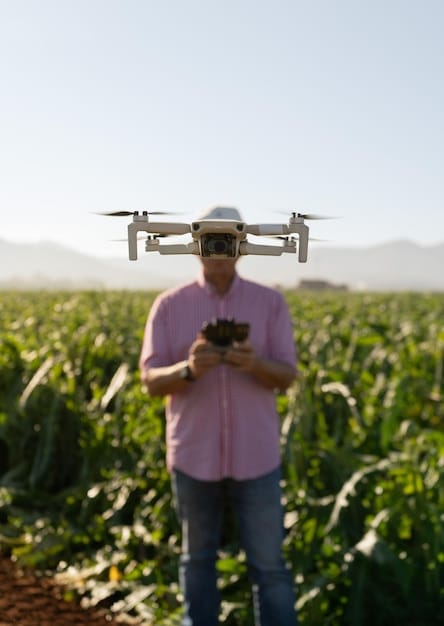
Frequently Asked Questions about US Robotics Growth
▼
The projected 12% growth is primarily driven by a convergence of several factors. These include significant advancements in AI and machine learning, persistent labor shortages across key industries, increased government and private investment in R&D, and the expanding application of robotics into diverse sectors like healthcare, logistics, and agriculture beyond traditional manufacturing.
▼
Labor shortages act as a strong catalyst for robotics adoption. Industries facing difficulties in finding human workers, particularly for repetitive, dangerous, or physically demanding tasks, are increasingly turning to robots to maintain productivity, ensure operational continuity, and relieve the burden on existing staff. Robots are seen as a solution to augment human capabilities rather than solely replace them.
▼
Government initiatives are crucial. Agencies like NSF, DARPA, and NIST provide significant funding for robotics research and development. Additionally, tax incentives, R&D credits, and programs aimed at workforce development encourage private sector investment and adoption. These policies create a supportive ecosystem for innovation and commercialization, accelerating the industry’s expansion.
▼
The application of robotics is rapidly expanding into numerous new sectors. Healthcare utilizes surgical robots and logistics automation. Logistics and warehousing leverage autonomous mobile robots for efficient fulfillment. Agriculture employs robots for precision farming, while retail and hospitality use them for inventory management and customer service. Construction is also seeing emerging robot applications.
▼
Key challenges include ensuring workforce adaptation through reskilling programs, addressing ethical considerations surrounding AI and automation, building robust and diversified global supply chains for components, fostering greater interoperability between systems, and developing more energy-efficient and environmentally sustainable robotic solutions. Proactive management of these areas is vital for long-term growth.
Conclusion
The projected 12% growth in the US robotics industry by 2025 is not merely a statistical forecast; it represents a fundamental shift in how industries operate and how work is performed. Driven by relentless technological innovation, the pressing need to address labor shortages, strategic governmental support, and the expansion into diverse new applications, robotics is poised to become an even more integral component of the American economy. While challenges exist, particularly concerning workforce transition and ethical AI development, proactive investments and collaborative efforts are paving the way for a future where intelligent automation enhances productivity, safety, and societal well-being. This robust growth trajectory firmly positions the US at the forefront of the global robotics revolution, promising transformative impacts for years to come.
